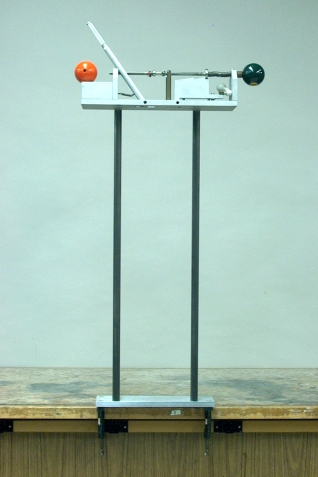

A video of this demonstration is available at this link.
A smaller version of this demonstration, shown below, is available for use in classrooms outside the Broida lecture hall building.
This apparatus simultaneously shoots the orange billiard ball horizontally to the left, and allows the green billiard ball to drop vertically. This is to illustrate motion in a plane, with constant acceleration in one direction (vertical), and zero acceleration, with both zero and non-zero speed, in a direction perpendicular to the first direction (horizontal).
To set the apparatus up (if it is not already), pull the lever (pointing upwards to the left at about a 60-degree angle) towards the right, until the disc on the rod catches in one of the two detents. The photograph above shows it in the second detent, where the spring is compressed further than it is at the first detent. Once you have cocked the apparatus, slip the green ball onto the end of the rod, and set the orange ball in the depression near the end of the block at left. Then pull the release lever at right (behind the apparatus, near the green ball). The orange ball shoots out horizontally, and the green ball drops. Because they started from the same height, with zero speed in the vertical direction, and both are subject to the (vertical) acceleration of gravity, both hit the floor at the same time, no matter which setting you use.
When you perform this demonstration, ask the students not only to watch, but also to listen for when the balls strike the floor. Since they arrive at the floor simultaneously, the class will hear a single “crack” when the balls hit the floor.
The equations for two-dimensional motion are identical to those for one-dimensional motion (illustrated by demonstrations 08.03 through 08.15), except that instead of having only one component, the vectors that describe a body’s position, velocity and acceleration have two components. The position, r, equals ix + jy, the instantaneous velocity, v, equals dr/dt = i(dx/dt) + j(dy/dt) = ivx + jvy, and the instantaneous acceleration, a, equals dv/dt = i(dvx/dt) + j(dvy/dt) = iax + jay. From these, it is straightforward to derive a set of equations that describe the motion of an object in a plane:
You can resolve the position, velocity and acceleration vectors into two components, which you can then treat independently. Doing this yields:
The initial velocity of the green billiard ball is zero, and when we drop it, gravity accelerates it downwards, in the negative y direction. The initial velocity of the orange ball is towards the left, in a horizontal direction (so in the negative x direction), and its acceleration is the same as that for the green ball. This is a special case of two-dimensional motion, in that the initial velocity vector is solely along the x-axis, and the acceleration is solely along the y-axis, so for each there is only one component.
For the vertical motion, we can rearrange the third equation in the table to get t = √(2(y - y0)/a). The initial height of the balls, y0, is about 1.74 m, so this becomes t = √(2*-1.74 m/-9.8 m/s2) = 0.60 s, the time it takes for the balls to strike the floor. Their vertical speed just as they land is vy = vy0 + ayt, or 0 m/s + (-9.8 m/s2)(0.6 s) = -5.9 m/s.
The horizontal distance the orange ball travels is x = x0 + (1/2)(vx0 + vx)t. Since it experiences no horizontal acceleration, its velocity is constant and we have x = x0 + vx0t. The horizontal distance from its launch point is thus vx0t, or, for the fall time of 0.60 s, vx0(0.6 s). For the second detent, vx0 is greater than for the first detent, and the distance at which the ball lands is correspondingly greater. In either case, if you measure the horizontal distance from the starting point, you can calculate vx0. In all of the foregoing, we have ignored the drag due to air resistance, which for the billiard balls is negligible.
The equations that describe the orange ball’s position at any time are y = -(1/2)gt2 and x = v0t. Combining these to eliminate t gives y = -(g/2v2)x2, or x2 = -(2v02/g)y, which is the equation of a parabola.
As noted above, a smaller version of this demonstration is available, which you can easily carry with you to any classroom:
This device as it appears in the photograph above is ready to fire, which you do by pushing down on the black stem just to the left of the ball support/launcher. When you do this, the spring quickly swings the ball launcher clockwise, dropping the front ball and launching the rear ball to the right. To reset the demonstration, rotate the ball launcher counterclockwise until it catches on the spring latch, and place the balls on the holes in the launcher. There is a storage compartment inside the unit to hold the balls when you are not using it.
References:
1) Resnick, Robert and Halliday, David. Physics, Part One, Third Edition (New York: John Wiley and Sons, 1977), ch. 3 and 4.